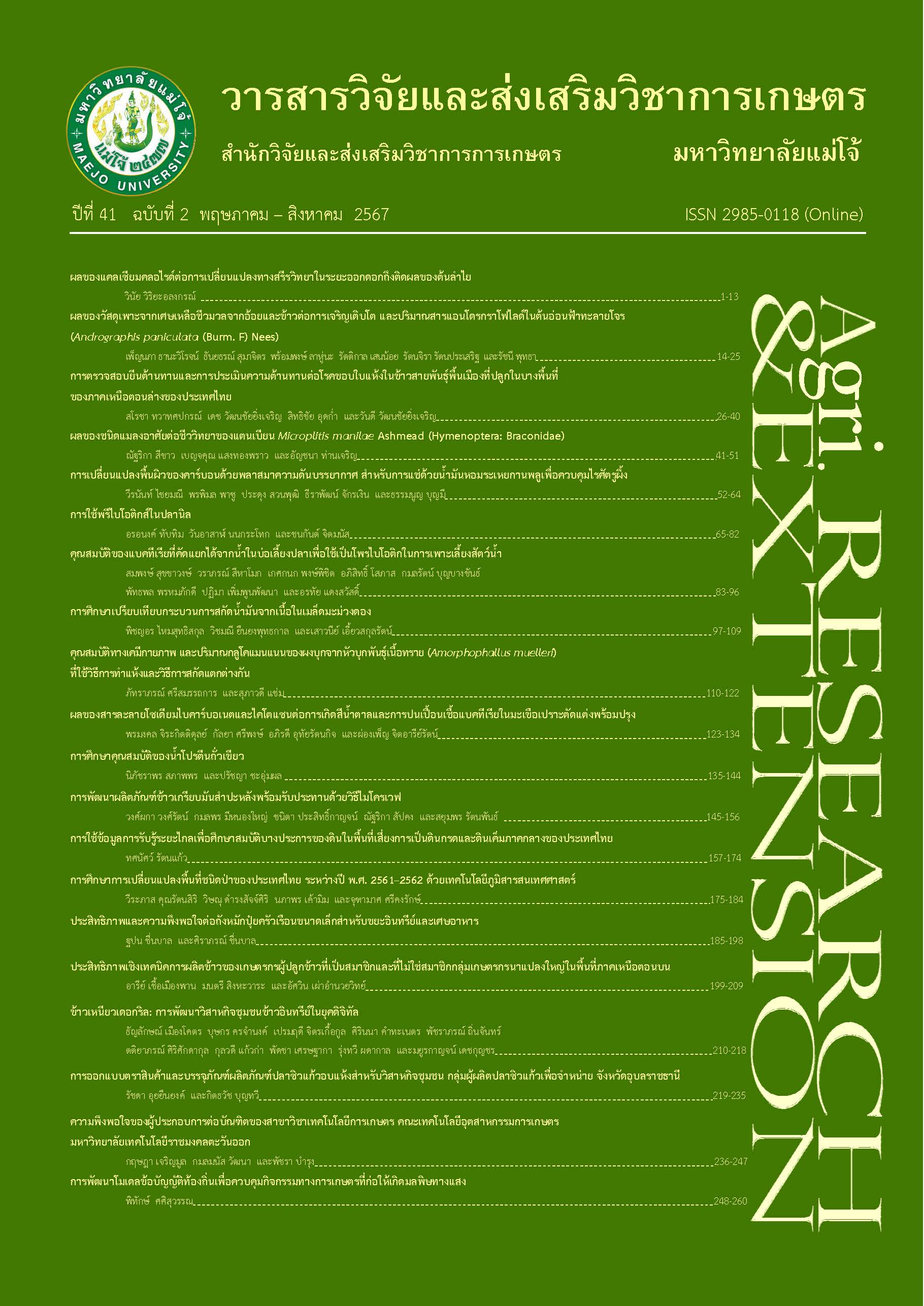การศึกษาเปรียบเทียบกระบวนการสกัดน้ำมันจากเนื้อในเมล็ดมะม่วงดอง
DOI:
https://doi.org/10.14456/jare-mju.2024.28คำสำคัญ:
น้ำมันเมล็ดมะม่วงดอง , สมบัติทางกายภาพ , สมบัติทางเคมี , การต้านอนุมูลอิสระ , กระบวนการสกัดบทคัดย่อ
เมล็ดมะม่วงดองเป็นของเสียตลอดทั้งปีที่ส่งผลกระทบสำคัญต่อสิ่งแวดล้อมในประเทศไทย การศึกษานี้จึงมีวัตถุประสงค์เพื่อศึกษาวิธีการสกัดที่เหมาะสมของน้ำมันเมล็ดมะม่วง (Mangifera indica L.) ดอง (Pickled mango kernel oil, PMKO) โดยใช้วิธีสกัดแบบ Soxhlet (SE) และวิธีสกัดเย็น (CPE) เพื่อนำไปต่อยอดในเชิงพาณิชย์ได้ น้ำมันที่สกัดได้ถูกนำมาวิเคราะห์สมบัติทางกายภาพ (อัตราส่วนการสกัด ความหนืด สี จุดหลอมเหลว และดัชนีการหักเหของแสง) และสมบัติทางเคมี (ค่าเปอร์ออกไซด์ ค่ากรด ค่าซาพอนิฟิเคชัน สารที่ไม่สามารถละลายน้ำได้ ค่าไอโอดีน TBARs รวมถึงฤทธิ์ต้านอนุมูลอิสระและฤทธิ์ต้านการอักเสบ) ผลการวิจัยพบว่า อัตราส่วนการสกัดและความหนืดของ PMKO ที่ได้จากวิธี CPE สูงกว่าของ SE น้ำมันที่สกัดได้จาก CPE มีสีน้ำตาลอมเหลืองอ่อน ค่าเปอร์ออกไซด์ต่ำ (1.93±0.06 meq peroxide/kg oil) ค่ากรดสูงเล็กน้อย (14.44±0.10 mg KOH/g oil) และเป็นของเหลวที่อุณหภูมิ 25°ซ. สมบัติต้านอนุมูลอิสระและต้านการอักเสบจาก PMKO แบบ CPE นั้นดีกว่าแบบ SE กิจกรรมต้านอนุมูลอิสระและ ต้านการอักเสบของ PMKO แบบ CPE เท่ากับ 71.87±1.09% (ยับยั้งที่ 50 mg) และ 81.47±0.98% (ยับยั้งที่ 100 mg) ตามลำดับ จากผลการวิจัยบ่งชี้ว่าเมล็ดมะม่วงดองเป็นแหล่งน้ำมันพืชที่ดี โดยการสกัดเย็นเป็นวิธีที่มีประสิทธิภาพและคุ้มค่าในการได้น้ำมันจากเมล็ดมะม่วงดอง
เอกสารอ้างอิง
Abdalla, A., S. Darwish, E. Ayad and R. El-Hamahmy. 2007. Egyptian mango byproduct 1. Compositional quality of mango seed kernel. Food Chemistry 103(4): 1134-1140.
Ahmed, S. and A.M. Mahmoud. 2015. A novel salting-out assisted extraction coupled with HPLC- fluorescence detection for trace determination of vitamin K homologues in human plasma. Talanta 144: 480-487.
Ali, M.A., M.A. Gafur, M.S. Rahman and G.M. Ahmed. 1985. Variations in fat content and lipid class composition in ten different mango varieties. Journal of the American Oil Chemists' Society 62(3): 520-523.
AOAC. 1990. Official Methods of Analysis of the AOAC. 15th edition. Association of Official Analytical Chemists, Washington DC: AOAC International. 1,298 p.
AOCS. 1998. Official Methods and Recommended Practices of the American Oil Chemists’ Society. 5th edition. Champaign IL: American Oil Chemists Society. 1,200 p.
Arogba, S. 1997. Physical, chemical and functional properties of Nigerian mango (Mangifera indica) kernel and its processed flour. Journal of Agricultural and Food Chemistry 73: 321-328.
ASTM. 2006. Standard test method for kinemetic viscosity of transparent and opaque liquid (and calculation of dynamic viscosity): D 445-06. 1-10. [Online]. Available https://www. scribd.com/document/474070419/D445-Viscosity-1-pdf (November 30, 2023).
Buege, J.A. and S.D. Aust. 1978. Biomembranes - Part C: Biological Oxidations, Microsomal lipid peroxidation. Methods in Enzymology 52: 302-310.
Cheng, J., S. Wang and H.W. Ockerman. 2007. Lipid oxidation and color change of salted pork patties. Meat Science 75: 71-77.
Codex Alimentarius. 2019. Codex Standard for Named Vegetable Oils (CODEX-STAN 210-1999). 1-10. [Online]. Available https://www.fao.org/3/y2774e/y2774e04.htm#bm4.1 (November 30, 2023).
Eromosole, C.O. and N.H. Paschal. 2003. Characterization and viscosity parameters of seed oils from wild plants. Bioscience Technology 86: 203-205.
Gunstone, F.D. 2011. Vegetable Oils in Food Technology: Composition, Properties and Uses. 2nd ed. Willy-Blackwell: CRC Press. 376 p.
Hernández-Santos, B., J. Rodríguez-Miranda, E. Herman-Lara, J.G. Torruco-Uco, R. Carmona-García, J.M. Juárez-Barrientos, R. Chávez-Zamudio and C.E. Martínez-Sánchez. 2016. Effect of oil extraction assisted by ultrasound on the physicochemical properties and fatty acid profile of pumpkin seed oil (Cucurbita pepo). Ultrasonics Sonochemistry 31: 429-436.
Jahurul, M.H.A., N.A.N. Norulaini, I.S.M. Zaidul, S. Jinap, F. Sahena, J. Azmir, K.M. Sharif and A.K. Mohd Omar. 2013. Cocoa butter fats and possibilities of substitution in food products concerning cocoa varieties, alternative sources, extraction methods, composition, and characteristics. Journal of Food Engineering 117(4): 467-476.
Jahurul, M.H.A., I.S.M. Zaidul, N.N.A. Norulaini, F. Sahena, J.M. Jaffri and A.K. Omar. 2014. Supercritical carbon dioxide extraction and studies of mango seed kernel for cocoa butter analogy fats. CyTA - Journal of Food 12(1): 97-103.
Jeyarani, T. and S.Y. Reddy. 1999. Heat-resistant cocoa butter extenders from Mahua (Madhuca latifolia) and Kokum (Garcinia indica) fats. Journal of the American Oil Chemists' Society 76(12): 1431-1436.
Kabuki, T., H. Nakajima, M. Arai, S. Ueda, Y. Kuwabara and S. Dosako. 2000. Characterization of novel antimicrobial compounds from mango (Mangifera indica L.) kernel seeds. Food Chemistry 71: 61-66.
Kaufmann, B. and P. Christen. 2002. Recent extraction techniques for natural products: microwave-assisted extraction and pressurized solvent extraction. Phytochemical Analysis 13: 105-113.
Kaur, G., D. Kaur, S.K. Kansal, M. Garg and M. Krishania. 2022. Potential cocoa butter substitute derived from mango seed kernel. Food Chemistry 372: 131244.
Kittiphoom, S. and S. Sutasinee. 2013. Mango seed kernel oil and its physicochemical properties. International Food Research Journal 20(3): 1145-1149.
Let, M.B.C. and A.S. Meyer. 2005. Sensory stability and oxidation of fish oil enriched milk is affected by milk storage temperature and oil quality. International Dairy Journal 15: 173-182.
Maheshwari, B. and S.Y. Reddy. 2005. Application of kokum (Garcinia indica) fat as cocoa butter improver in chocolate. Journal of the Science of Food and Agriculture 85: 135-140.
Maisuthisakul, P. and M.H. Gordon. 2009. Antioxidant and tyrosinase inhibitory activity of mango seed kernel by product. Food Chemistry 117: 332-341.
Maisuthisakul, P. and L. Changchub. 2018. Effect of extraction method on physical and chemical properties of mango kernel oil. Agricultural Science Journal 49(2)(Suppl.): 53-56.
Sakat S., A.R. Juvekar and M.N. Gambhire. 2010. In Vitro antioxidant and anti-inflammatory activity of methanol extract of Oxalis corniculata Linn. International Journal of Pharmacy and Pharmaceutical Sciences 2(1): 146-155.
Schäffer, B., S. Szakály and D. Lőrinczy. 2001. Melting properties of butter fat and the consistency of butter: effect of modification of cream ripening and fatty acid composition. Journal of Thermal Analysis and Calorimetry 64: 659-669.
Singleton, V. and J. Rossi. 1965. Colorimetry of total phenolic compounds with phosphomolybdic-phosphotungstic acid reagents. American Journal of Enology and Viticulture 16: 144-158.
Sonwai, S., P. Kaphueakngam and A. Flood. 2014. blending of mango kernel fat and palm oil mid-fraction to obtain cocoa butter equivalent. Journal of Food Science and Technology 51: 2357-2369.
Soong, Y.Y. and P.J. Barlow. 2004. Quantification of gallic acid and ellagic (Mangifera indica L.) kernel and their effects on antioxidant activity. Food Chemistry 97: 524-530.
Yousefi, M., M. Rahimi-Nasrabadi, S.M. Pourmortazavi, M. Wysokowski, T. Jesionowski, H. Ehrlich and S. Mirsadeghi. 2019. Supercritical fluid extraction of essential oils. TrAC Trends in Analytical Chemistry 18: 182-193.
Zaidul, I.S.M., N.A.N. Norulaini, A.K. Mohd Omar, and R.L. Smith Jr. 2007. Blending of supercritical carbon dioxide (SC-CO2) extracted palm kernel oil fractions and palm oil to obtain cocoa butter replacers. Journal of Food Engineering 78: 1397-1409.
ดาวน์โหลด
เผยแพร่แล้ว
รูปแบบการอ้างอิง
ฉบับ
ประเภทบทความ
สัญญาอนุญาต
ลิขสิทธิ์ (c) 2024 วารสารวิจัยและส่งเสริมวิชาการเกษตร

อนุญาตภายใต้เงื่อนไข Creative Commons Attribution-NonCommercial-NoDerivatives 4.0 International License.
บทความนี้ได้รับการเผยแพร่ภายใต้สัญญาอนุญาต Creative Commons Attribution-NonCommercial-NoDerivatives 4.0 International (CC BY-NC-ND 4.0) ซึ่งอนุญาตให้ผู้อื่นสามารถแชร์บทความได้โดยให้เครดิตผู้เขียนและห้ามนำไปใช้เพื่อการค้าหรือดัดแปลง หากต้องการใช้งานซ้ำในลักษณะอื่น ๆ หรือการเผยแพร่ซ้ำ จำเป็นต้องได้รับอนุญาตจากวารสาร





